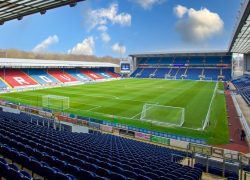Ewood Park is a renowned football stadium and the home of Blackburn Rovers F.C. The club has played at Ewood Park since 1890, making it one of the oldest football grounds in the country. The stadium has undergone significant redevelopment over the years and now stands as a modern, all-seater facility with a capacity of 31,367.
Ewood Park is divided into four main sections: the Bryan Douglas Darwen End, Riverside Stand, Ronnie Clayton Blackburn End, and Jack Walker Stand. The sections are named after notable individuals associated with Blackburn Rovers. The football pitch itself measures 115 by 76 yards (105 m × 69 m).
The history of Ewood Park dates back to the 1880s when football matches, athletics events, and greyhound racing took place on the site. The ground officially opened in April 1882, and Blackburn Rovers moved in permanently in 1890 after purchasing the freehold of the land. Over the years, the stadium has witnessed various developments and renovations.
One notable incident in Ewood Park’s history occurred in 1913 when suffragettes attempted to burn down the grandstand as part of their campaign for women’s suffrage. Despite this incident and other challenges faced, the stadium continued to evolve. The ground saw the construction of the Nuttall Street Stand, a roof on the Darwen End, and the addition of floodlights in 1958.
In the late 20th century, Jack Walker, a local industrialist and Blackburn Rovers supporter, purchased the club and initiated a comprehensive redevelopment of Ewood Park. This transformation included the construction of new stands, such as the Jack Walker Stand, Blackburn End Stand, and Darwen End Stand. The new Ewood Park was officially opened in November 1995.
The Jack Walker Stand, the largest stand at Ewood Park, honours the former club owner and accommodates 11,000 seats. It houses the home and away dressing rooms, media facilities, hospitality areas, and the club shop. The Ronnie Clayton Blackburn End, built in the early 1990s, has 8,000 seats and features a memorial garden and a statue of Jack Walker. The RFS Riverside Stand, which replaced the old stand in 1988, holds approximately 6,000 spectators and displays the word “ROVERS” through its seating arrangement. The Bryan Douglas Darwen End, also constructed in the early 1990s, mirrors the Blackburn End in appearance and capacity.
In addition to football matches, Ewood Park has hosted various other events, including international matches, FA Cup semi-finals, rugby league tests, and concerts. The stadium holds a special place in the hearts of Blackburn Rovers fans and has been an integral part of the club’s history.
Ewood Park continues to be an iconic venue for football in Lancashire, offering a memorable experience for both home and away supporters. Its rich heritage, modern facilities, and passionate atmosphere make it a must-visit destination for football enthusiasts.

